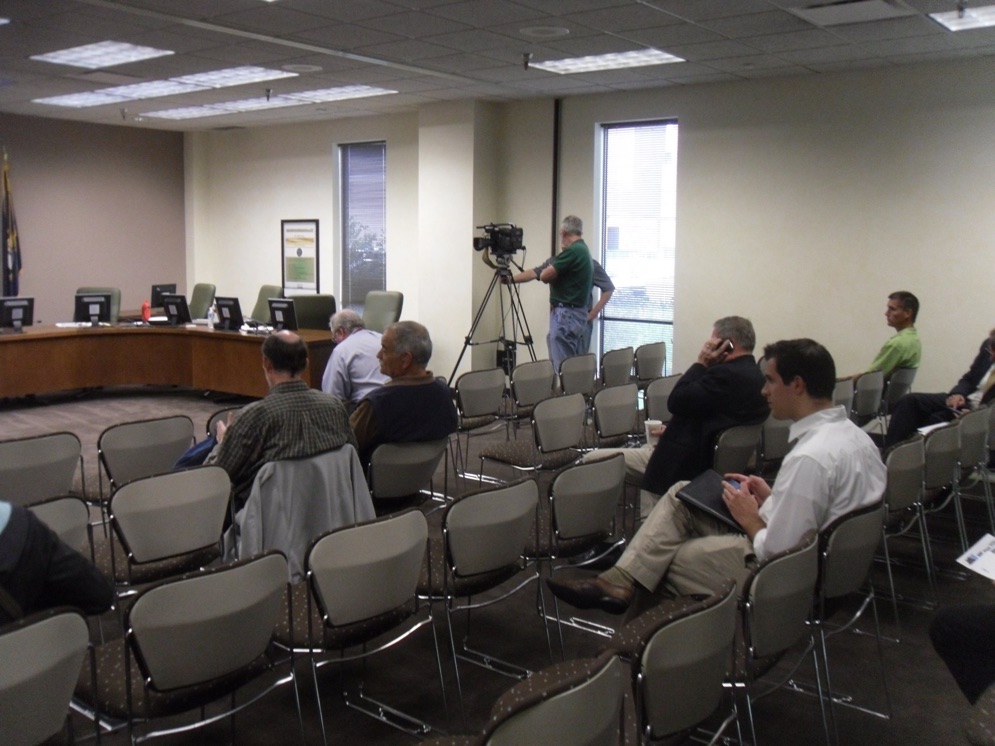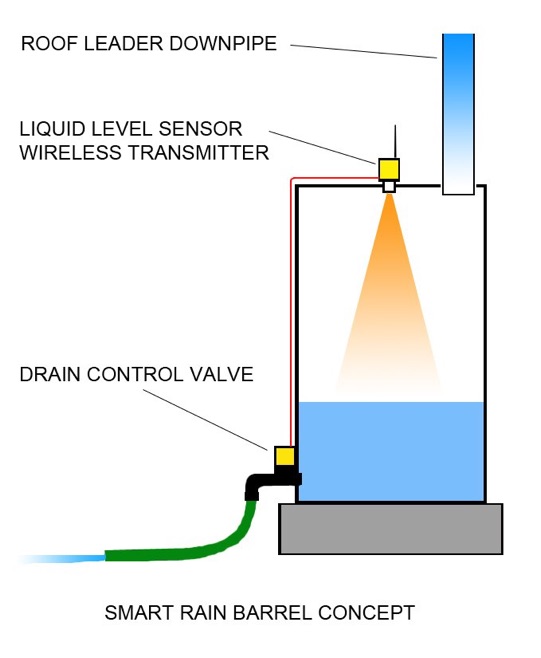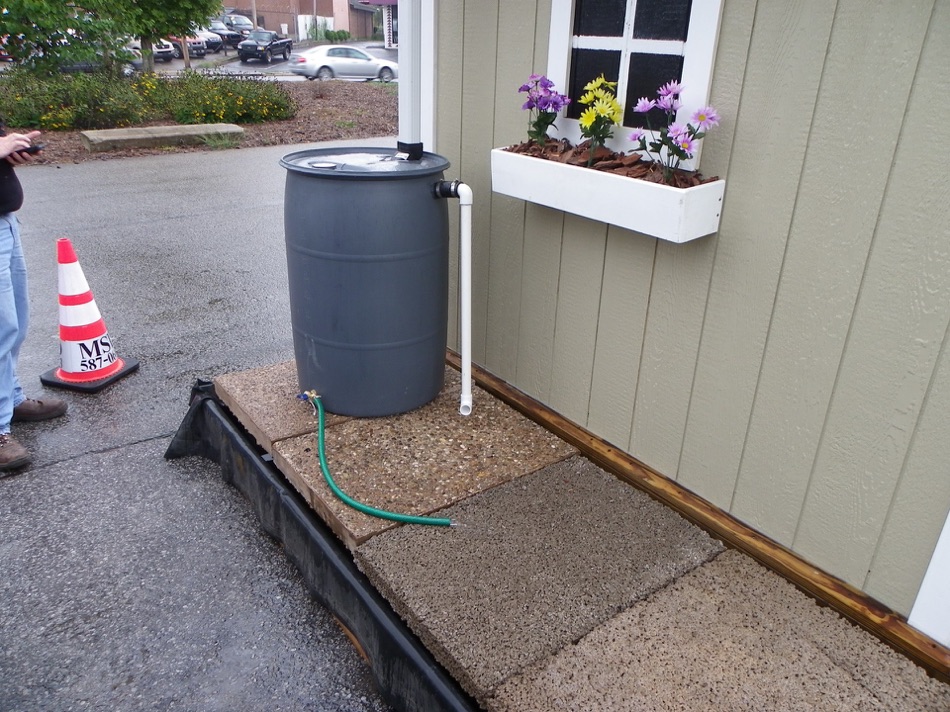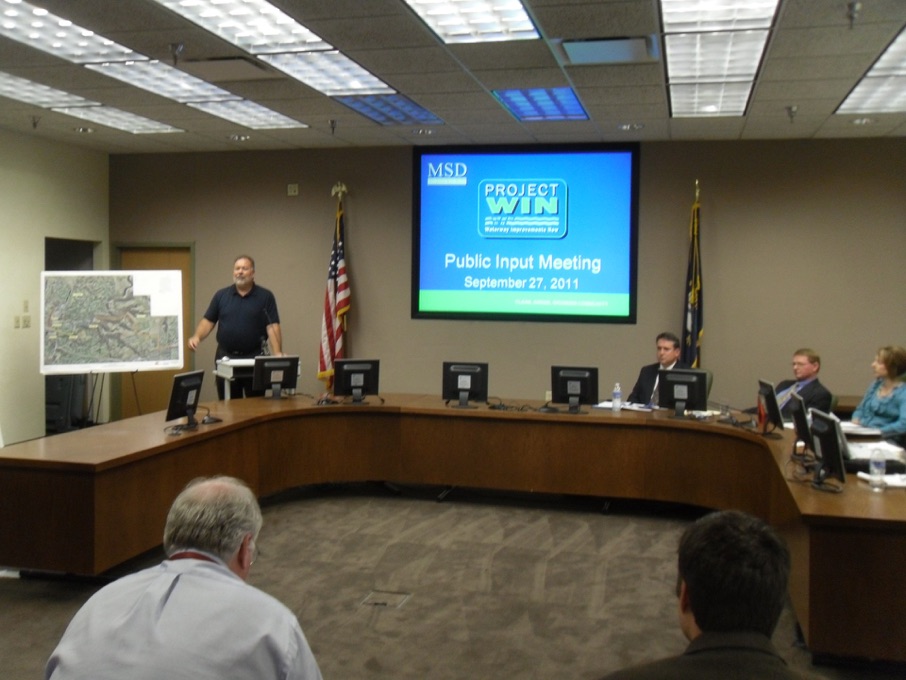Published online at Louisville, Kentucky USA -
An independent, secular, contemporary journal of political and environmental issues dedicated to peaceful reduction of human impacts on Earth
Published online at Louisville, Kentucky USA -
An independent, secular, contemporary journal of political and environmental issues dedicated to peaceful reduction of human impacts on Earth

BadwaterJournal.com
WHAT UNSUSTAINABLE URBAN GROWTH LOOKS LIKE

Engineer Brian Bingham conducts the public meeting
Why not?
I pressed MSD engineers to answer why installing 100,000 rain barrels in the watersheds to keep rain water from entering into the sewer pipes to begin with was not a preferable plan to building a $ 30 million dollar concrete basin and leveling a forest to build it?
If a rain barrel costs a home owner $ 100 dollars and holds fifty galllons you can install 5 million gallons of clean water storage for $ 1 million dollars instead of paying $ 12 million for 2.74 million gallons of storage of rain water mixed with sewage that must then be sent to the treatment plant for expensive treatment. Keeping rain water out of the sewer system saves money and allows reduced size big concrete projects.
The engineers categorically rejected this challenge to their big dig project saying that EPA would not allow them to propose a project they could not control. They could not depend on home owners to empty rain barrels during dry periods--so there was no reliable guarantee that the rain water removal would actually occur.
The Board room later filled up with engineers and local folks to see a series of presentations
MSD engineers fielded questions and engaged in lively discussion of the selected IOAP projects
Justin Gray answered specific questions about the CSO 127 Overflow Basin
Angela Ackridge gave an overview of the IOAP
Analysis
MSD’s Big Dig major sewer projects will fill the pockets of concrete contractors and engineering firms
MSD’s $ 850 million Integrated Overflow Abatement Plan - IOAP was summarized for the public in an Open House at MSD’s main office yesterday, September 27th 2011. The cordial public consultation process included a chance to sit a table with young MSD engineers who tried to explain the complex plan and answer questions. As an attempt to comply with the public consultation requirements for agencies governed by the Clean Water Act--I grade it, A plus.
It was such a good effort, I regret having to complain that it should have come a year earlier before such projects as the long sewer trunk lines being built in the Floyds Fork watershed to remove sewer flow from the Jeffersontown treatment plant, broke ground. What MSD presented yesterday was in many areas a done deal, with no chance for the public to make meaningful comment or see what alternatives might be considered.
In the case of the closure of the polluting Jeffersontown treatment plant, the selected engineering fix includes transporting east end industrial and residential wastewater halfway across the county out of the Chenoweth Run watershed into the South Fork of Beargrass Creek watershed and thence to the Morris Forman or Derek Guthrie treatment plants. The growing industrial corridor around J-town will not have to include a local wastewater treatment plant to remove the industrial discharges, and in a range of storms that exceed the design capacity of the new pump stations and trunk lines, new sewer overflows containing east end wastewater may pop up along the length of the massive trunk lines.

Expanding cost of major projects
MSD is presently being audited by the state auditor’s office. Some of the projects previously announced have grown in scope and expense. MSD engineers reported that the Grinstead-Lexington Road CSO 127 Overflow Basin had previously been sized based on a flawed computer model. The model predicted sewer overflow volumes that would have to be contained for MSD to meet its goal of allowing no more than 8 overflows per year through those CSOs. The prior estimate was the need for a 2.74 million gallon basin to be located behind Jim Porters Tavern in the wetlands along the Middle Fork of Beargrass Creek. That massive concrete capped tank was estimated to cost $ 12,950,000.00.
MSD subsequently did actual flow measuring and recalibrated their computer model. The result was up sizing the basin to hold 12 million gallons and its now expected to cost $ 30 million dollars.
This capacity has no reduction for any storm water capture in the local neighborhoods that would reduce the amount of storm water that goes into catch basins and through roof downspouts into the combined sewer pipes.



Smart barrels would be fitted with sensors and valve controls to form an integrated, distributed system of large capacity without disturbing the creek and forest.
A ‘dumb’ rain barrel attached to a downspout and shown discharging on pervious pavement that allows water to infiltrate the soil below. Mandatory installation would require Metro Council to pass an ordinance and amend the storm water master plan.
Distributed barrel networks are a valid
alternative to massive single concrete
overflow basins costing in excess of
$ 30 million dollars.
Rain barrels discharge clean water into
local lawns and gardens and never add to
amounts that have to flow to treatment
plants for pollution treatment. This reduces
the cost of expensive wastewater treatment
and removes stormwater volume from
sewer pipes reducing overflows.
Modern continuous fluid level sensors
can be installed and valve controls on drains
would allow MSD to control a distributed
barrel system to conform to rainfall
conditions allowing reliable storage capacity
monitoring and control.
These systems are now in use in oil tank farms
and other fluid storage control operations.
Since the cost and destruction of installing
a $ 30 million dollar concrete tank could be
avoided, the alternative should be given
engineering consideration and cost-
benefit analysis.
related story on the
Tire Wear Tokyo page HERE

Smart Rain Barrels for on-site storage
I broached an idea with the MSD engineers that storm water could be kept from entering the sewer system by using on site rain barrels and requiring detention capacity based on parking lot size and large impervious roofs. Control and capacity by MSD could be assured by having sensors installed that would be connected to an internet connection so that MSD could monitor real time capacity of the distributed rain barrels and could open or close their drain valves to respond to conditions.
This alternative would be vastly cheaper that building major concrete basins and the stored water would never come into contact with sewage and then have to be treated. Less pollution, less expense, no treatment expense, and MSD could furnish a high speed internet connection to all Louisville homes along with the control system. WOAA!!
That didn’t fly with the engineers. Politics prohibits MSD form encroaching on public property they say. They are loath to seek a municipal ordinance that would require home owners to share the cost of installing and maintaining a ‘smart barrel.’ Though we charge $ 100 a day for letting the weeds grow too big on property under the property maintenance code as passed, MSD will not seek an ordinance requiring big homes to install capture systems on residences and private commercial property to keep the streams from being polluted. They prefer big concrete.
Information and Understanding Gap
The public comment meeting demonstrated how significantly the participation of the general public has declined in wastewater issues. The attendees generally sat mute taking in the MSD presentation on the complex IOAP either little understanding the details or unsure of what they thought about it.
MSDs projects will build major sewer trunk lines in creek bed areas, disturbing the banks in Chenoweth Run and the South Fork of Beargrass Creek for long stretches. Sewage from the wealthy high income J-town area will be pumped and flow to the west and south end with possible new overflows from appurtenances along the route. The dirty pollution that plagued Chenoweth Run for many years may be displaced to new creek locations. MSD did not present a comparison of present SSO sanitary sewer overflows with anticipated capacity problems and likely overflows caused by the newly installed system. Thus, the public is left to wonder what if any, new impacts will occur and their locations. Bottling up industrial wastewater from the J-town area and sending it across town may create acute pollution in an overflow at a distant manhole or constructed overflow.


© 2015 Bud Hixson